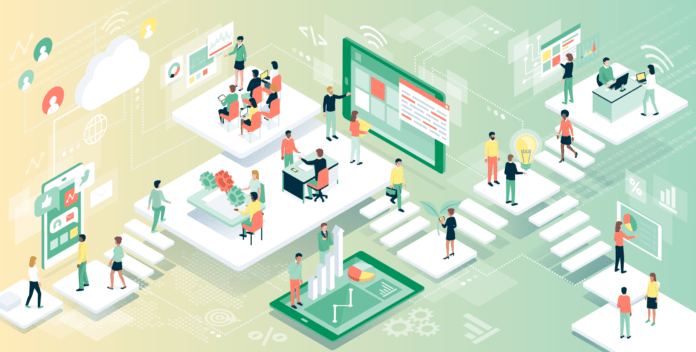The Covid-19 pandemic has disrupted life and lifestyles of people across the globe. Government has enforced lockdowns to curb the spread of the deadly virus.
Work from home is the new reality for many businesses as they struggle to operate during these uncertain times.
Schools and colleges are conducting online classes to complete their syllabus; social distancing is the new norm in grocery stores and E-commerce companies are making Covid-safe deliveries to their customers.
In this new reality, communication technology offers solutions to overcome some of the challenges thrown up by the pandemic.
Here are a few of the technology trends in the field of communication which are poised to redefine a post Covid-19 world.
1. “Virtual” meetings: With lockdowns, and travel restrictions, face-to-face meetings and ‘huddles’ will need to be redefined. Industry will experience an increase in virtual meetings. Already, applications like Zoom and Google Meet have seen a sudden spurt in users. From meetings with only 4-5 participants, to huge international seminars and conferences with thousands of participants all have already moved online. This trend is likely to continue in the post Covid world as people maintain social distancing etiquette
2. Online Education: Post the lockdown, a large chunk of academia has gone online. Schools, colleges and coaching centres are conducting online classes via video conferencing. Dedicated education apps have witnessed a huge spurt in growth as students are learning concepts on their mobile phones. A few colleges have also conducted tests online.
It is expected that some of these trends will continue in the post Covid period as well. Many universities and school education boards have recommended that schools and colleges should attempt to complete some portion of the curriculum online, even after the situation becomes normal.
3. 5G: With the increasing demand for faster and higher bandwidth networks, due to remote working, 5G which is the next generation network designed with “Service Based” architecture might get adopted faster. 5G provides greater quality of service based on the network ‘Slice”, which caters to a particular service type, such as IoT, Low latency applications etc.
For example, for a remote surgery use case, where low latency is a critical parameter, 5G can perform better than the current networking solutions.
4. Shared Spectrum: Technology trends make it clear that in a post Covid world, more content will be watched and consumed on mobile devices, be it in form of video conferencing for a meeting, an online class, or Video for entertainment. Even before the pandemic, video occupied over 70% of the content transmitted over the mobile network. This will rise exponentially in the post Covid world and will overburden mobile networks which are not designed to handle such load.
To prevent network congestion and improve user experience, the communication companies will use “Shared” spectrum. There are various types of shared spectrum options. Dynamic shared spectrum such as TVWS, CBRS give additional coverage and capacity to provide connectivity to unconnected population. We can also have sharing of spectrum between two different networks- such as Broadband and Broadcast networks. One such example of a shared spectrum is Saankhya Labs’ 5G broadcast. This is a 5th generation data transmission innovation which is a convergence of Broadcast and Broadband spectrum.
5. AI/ML based Communication: Artificial Intelligence and Machine Learning (AI/ML) will be playing an increased role in the communication solutions of the future. When communication is being done using shared spectrum AI/ML systems will be continuously monitoring the load on the various networks.
Based on the data type, network load and number of users the AI/ML systems can help networks make a decision to choose the most optimum parameters to deliver content – For example: networks can make a decision to switch the transmission from one spectrum to other on a real time basis. These systems will help greatly improve the user experience.
6. Virtualization: With more data being transmitted the mobile operators would have to ramp up the network infrastructure in order to support this large volume of data. Ramping up physical infrastructure is very costly so many operators will opt for virtualization to reduce the capex and opex.
For example, RAN virtualization is adopted by many network operators which separates the network functions from the hardware. This gives scalability, elasticity and lead to a more flexible, agile and cost-effective network. Virtualization also will lead to dis-aggregation and open network architectures. This also gives way for innovation and newer players to provide cutting edge technology to better manage the network.
7. Rural Broadband: Covid-19 has changed the demographics of cities. The lockdown followed by the loss of jobs triggered a reverse migration from cities to villages.
It is not certain how many of them will chose to return once the pandemic scare has passed. However, it is envisaged that the migrant population will take back some city amenities, such as 24-hour internet connectivity.
Mobile internet connectivity and the world of opportunities that it opens up will lead to a greater demand for high speed internet connectivity in rural areas as well – for everything, from govt. services to tele-education, tele-medicine to e-commerce. Many innovative wireless technologies can provide faster and cost effective alternatives to current optical network solution to rapidly deploy connectivity across the country. One such example is IEEE802.22 based Fixed Wireless Access technology which utilizes unused UHF spectrum and can be used for middle mile and last mile network coverage.
8. IoT Solutions: There has been a rapid proliferation of “smart” devices which are connected to the internet. Post Covid-19, as a result of social distancing norms, there will be a larger growth in such devices. We will see the use of “Smart” devices in “Smart” homes.
For example, “smart” refrigerators will take stock and order groceries online. Such “Smart” devices will require regular software upgrades which will be transmitted via the internet. Companies could use 5G broadcast to broadcast a software upgrade patch to all their devices, making it cost effective while also reducing congestion in the mobile network
9. Remote Sensors and Monitoring Solutions: Slowdown in travel will ultimately lead to proliferation of remote sensors and monitoring solutions. These sensors and monitors will be installed in remote areas like agricultural fields, oil rigs, remote factories and warehouses, mines etc.
They could be controlled and monitored from a central location. Fixed Wireless Access solutions can be used to provide connectivity between the central location and the remote locations.
10. Satellite based asset tracking solutions: In many places across the country where mobile network connectivity is patchy, there will be an increase in remote asset tracking solutions.
This is because movable assets such as trains, trucks, fishing boats, etc continuously move in these areas. In the absence of mobile network connectivity, satellite connectivity will be used to send and receive data from a central control location
All these trends indicate that communication technology will play a great role in reshaping a post Covid-19 world.
(The author is Co-Founder and CEO, Saankhya Labs.)












